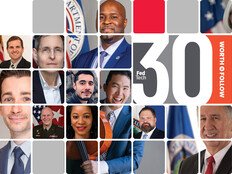Government Offers Millennials Meaningful Work but Little Reward for Innovation and Creativity
The government is succeeding when it comes to selling the mission and importance of federal work to budding professionals within its ranks. But according to government data, many agencies are falling short in key areas, such as offering career advancement opportunities for their younger workers and rewarding innovation and creativity.
A new report released Wednesday by the Office of Personnel Management (OPM) shows that just one-third of millennials in government say creativity and innovation are rewarded in their organizations, and nearly two-thirds are not satisfied with opportunities for career advancement.
Innovation and career advancement are huge selling points for millennials as they navigate career paths and weigh offers from private-sector competitors, many of which promote innovation.
The government defines millennials as individuals who are under the age of 33. Today, they make up only 16 percent of the federal workforce, or about 336,000 employees. About 2 percent, or 7,657, hold information technology management jobs. Governmentwide, IT is one of the top 10 occupations for millennials.
The median tenure for millennials in government is 3.8 years.
Government needs to recruit and retain millennials in ways that are different from those used with Generation X and baby boomers, OPM Director Katherine Archuleta told reporters Wednesday. Millennials aren’t looking for one job to keep them employed; they’re looking for opportunities that allow professional growth.
“You can come into government, and we will offer you an incredible opportunity that will help you build your resume as you think about your [long-term] career,” Archuleta said.
She noted that limited budgets have stymied funding in the past for career-development opportunities, but she expects that agencies will boost investments in training, now that more funding is available.
OPM’s report is based on results from the 2014 Federal Employee Viewpoint Survey. The annual survey, which has not yet been released, provides agencies with valuable feedback from their workforce about work environment, managers and overall satisfaction with government work.
The report is the first in a series that will take a deeper look at the survey results and marks the first time that OPM has reported on millennials in the federal workforce. “We’re going to use this data to continuously improve and make the federal government a model employer,” Archuleta said.
Keeping Millennials Happy and Engaged
This year, OPM launched a pilot program called GovConnect, which “allows employees to take a few hours each week to pursue a project that they are interested in and that demonstrates promise but that is not part of their everyday work assignments,” the report noted. The Environmental Protection Agency and the departments of Housing and Urban Development and State departments have launched versions of the program.
Governmentwide, 61 percent of millennials are satisfied with their jobs, and 62 percent would recommend their organization as a good place to work, the report notes. Eighty-six percent said the work they do is important. When it comes to interacting with managers, 77 percent said their supervisors listen to what they have to say, and 83 percent said their supervisors treat them with respect.
Attracting Millennials to Fill STEM Jobs
Recruiting younger employees who are adept in science, technology, engineering and math is a high priority for the government.
Archuleta and her team have been traveling the country to meet with educators and students at historically black colleges and universities, as well as schools with strong STEM programs and a diverse student population.
Millennials make up 15 percent of the federal workforce in STEM occupations, according to OPM data. Recruitment and retention efforts to attract more talent in these areas are critical, considering nearly half the federal workforce is nearing retirement age.
Recruitment efforts have been targeted in several states, including California, Arizona, Florida, Ohio, Pennsylvania, New York, Washington state and the D.C. area, says Carmen Andujar, OPM’s manager of recruitment policy and outreach.
A lot of millennials think they have to move to D.C. to get a government job, and students and career counselors know very little about government internships, such as the Pathways Programs, Andujar explains. Informing students of federal opportunities in their states is part of the recruitment push.
Agencies are moving away from the traditional tri-fold brochures and are using social media platforms such as LinkedIn, Twitter and Facebook to connect with students. But navigating USAJOBS.gov, the main portal for finding government jobs, has been a barrier to entry for many job seekers. OPM has vowed to make the site more user-friendly and is using focus groups and online feedback to improve the website.









